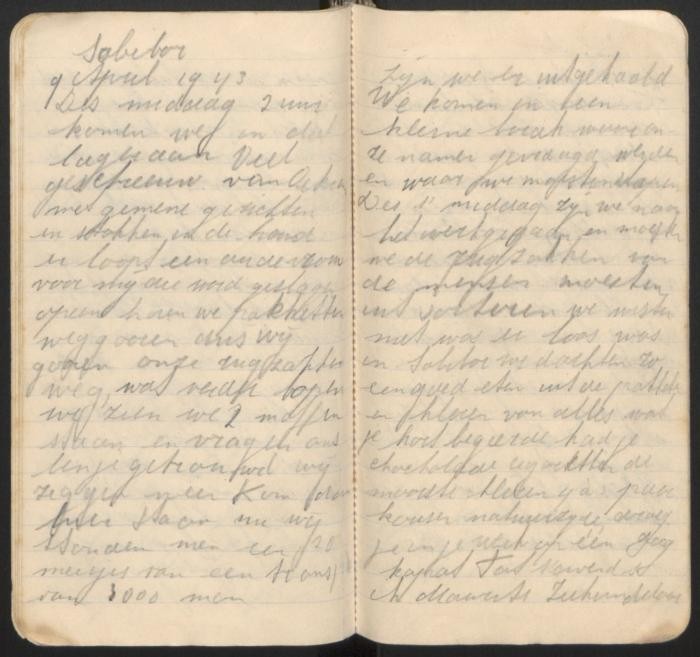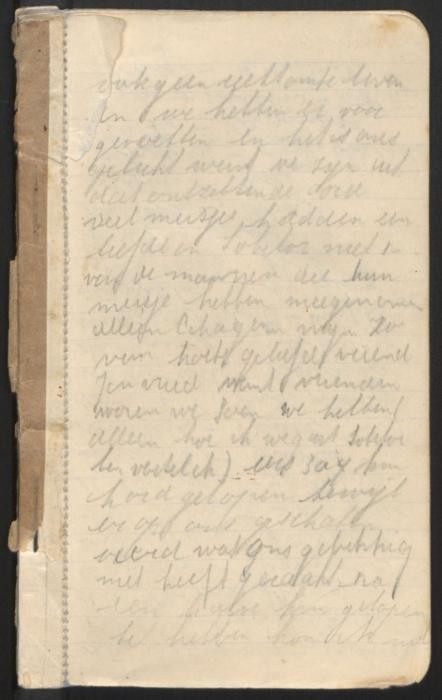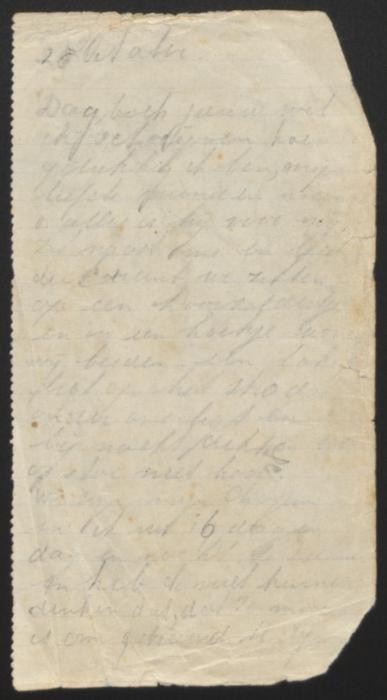Explore Selma Engel's testimony and diary pages about her deportation to and escape from the Sobibor killing center in German-occupied Poland.
Selma was the youngest of four children born to Jewish parents. When she was 7, Selma and her family moved to the town of Zwolle where her parents ran a small hotel. When the Germans invaded the Netherlands in 1940, they confiscated the hotel. The family had to live in a poor Jewish section of the town. Selma went into hiding but was betrayed and then sent to the Westerbork camp. In April 1943 she was deported to Sobibor, where she worked in the clothes sorting area. There, the prisoners tried to pocket food and valuables and ruin the clothes so the Germans could not use them. Selma met her future husband, Chaim, who was helping to plan a prisoner uprising. When the revolt began, they escaped and used some money taken from the clothing to buy shelter in a barn. They left Poland after the war because of violent antisemitism, moving first to the Netherlands in 1945, then to Israel in 1951, and finally to the United States in 1957.
Browse Selma Engel's diary and other papers
Item View
Diaries reveal some of the most intimate, heart-wrenching accounts of the Holocaust. They record in real time the feelings of loss, fear, and, sometimes, hope of those facing extraordinary peril.
Selma Wijnberg and Chaim Engel met and fell in love in the Sobibor killing center. After the young couple made a daring escape during the camp uprising and fled into hiding, Selma began a diary to record their experiences. The diary was written in 1943-1944 while Selma was in hiding in German-occupied Poland. This page recounts her arrival in Sobibor on April 9, 1943.
Item ViewSelma was the youngest of four children born to Jewish parents. When she was 7, Selma and her family moved to the town of Zwolle where her parents ran a small hotel. When the Germans invaded the Netherlands in 1940, they confiscated the hotel. The family had to live in a poor Jewish section of the town. Selma went into hiding but was betrayed and then sent to the Westerbork camp. In April 1943 she was deported to Sobibor, where she worked in the clothes sorting area. There, the prisoners tried to pocket food and valuables and ruin the clothes so the Germans could not use them. Selma met her future husband, Chaim, who was helping to plan a prisoner uprising. When the revolt began, they escaped and used some money taken from the clothing to buy shelter in a barn. They left Poland after the war because of violent antisemitism, moving first to the Netherlands in 1945, then to Israel in 1951, and finally to the United States in 1957.
Browse Selma Engel's diary and other papers
Item View
Diaries reveal some of the most intimate, heart-wrenching accounts of the Holocaust. They record in real time the feelings of loss, fear, and, sometimes, hope of those facing extraordinary peril.
Selma Wijnberg and Chaim Engel met and fell in love in the Sobibor killing center. After the young couple made a daring escape during the camp uprising and fled into hiding, Selma began a diary to record their experiences. The diary was written in 1943-1944 while Selma was in hiding in German-occupied Poland.
This page recounts Selma and Chaim's escape from the camp.
Item View
Diaries reveal some of the most intimate, heart-wrenching accounts of the Holocaust. They record in real time the feelings of loss, fear, and, sometimes, hope of those facing extraordinary peril.
Selma Wijnberg and Chaim Engel met and fell in love in the Sobibor killing center. After the young couple made a daring escape during the camp uprising and fled into hiding, Selma began a diary to record their experiences. The diary was written in 1943-1944 while Selma was in hiding in German-occupied Poland.
This page recounts Chaim and Selma's life in hiding following their escape: "We are in a little hayloft and live together in a little corner. There is a sheet on top of the straw below us and we cover ourselves at night with hay."
Item View![Selma Wijnberg [LCID: 1703] Selma Wijnberg [LCID: 1703]](https://encyclopedia.ushmm.org/images/large/b54a3ac7-47db-4790-b04a-e5ab9681d2df.gif)
Selma was the youngest of the Wijnberg's four children, and the only daughter. When she was 7, her family left Groningen to start a business in the town of Zwolle [in the Netherlands]. There her parents ran a small hotel popular with Jewish businessmen traveling in the area. Every Friday there was a cattle market, and many of the cattle dealers came to the Wijnberg's hotel for coffee and business.
1933-39: At home Selma and her family were observant of Jewish tradition because her mother was religious. Their hotel observed the Jewish dietary laws. At the end of Friday evening prayers, they'd gather at home around the table and sing Hebrew songs. They'd also go to synagogue every Saturday and return home to a sumptuous meal. Selma was very active in Zionist activities and attended Zionist camps every summer.
1940-44: The Germans invaded the Netherlands in May 1940. In 1943 Selma was deported to the Sobibor killing center, where she was one of a few kept alive to work. At the end of her first day at Sobibor they gathered for roll call in the open area of Camp #1. There was a fire from Camp #3; the stench of burning flesh was overwhelming. Someone asked Selma, "Do you know what that fire means?" She shook her head. He explained it was the funeral pyre of their transport. Then the Germans ordered them to dance in couples, while a prisoner played the violin.
To her knowledge, Selma was the only native Dutch inmate who survived the Sobibor killing center. After the war she married. In 1957 she and her husband settled in the United States.
Item View
We would like to thank Crown Family Philanthropies, Abe and Ida Cooper Foundation, the Claims Conference, EVZ, and BMF for supporting the ongoing work to create content and resources for the Holocaust Encyclopedia. View the list of donor acknowledgement.